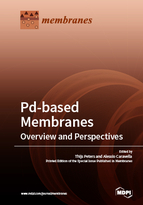Pd-based Membranes: Overview and Perspectives
A special issue of Membranes (ISSN 2077-0375). This special issue belongs to the section "Membrane Analysis and Characterization".
Deadline for manuscript submissions: closed (17 October 2018) | Viewed by 58388
Special Issue Editors
Interests: ceramic membranes; microporous membranes; gas separation; membrane reactors; carbon capture; hydrogen production and purification; catalytic membranes; metal membranes
Special Issues, Collections and Topics in MDPI journals
Special Issue Information
Dear Colleagues,
Palladium (Pd)-based membranes have received a great deal of attention from both academia and industry thanks to their ability to selectively separate hydrogen from gas streams. Integration of such membranes with appropriate catalysts in membrane reactors allows for hydrogen production with CO2 capture that can be applied in smaller bioenergy or combined heat and power (CHP) plants, as well as in large-scale power plants. Pd-based membranes are, therefore, regarded as a Key Enabling Technology (KET) to facilitate the transition towards a knowledge-based, low carbon and resource-efficient economy.
This Special Issue on “Pd-Based Membranes: Overview and Perspectives” of the journal Membranes seeks contributions to assess the state-of-the-art and future developments in the field of Pd-based membranes. Topics include, but are not limited to, alloy development, manufacturing techniques, transport phenomena, module and reactor design, membrane reactors, novel applications, and demonstration efforts and industrial exploitation. Authors are invited to submit their latest results; both original papers and reviews are welcome.
Dr. Thijs Peters
Prof. Alessio Caravella
Guest Editors
Manuscript Submission Information
Manuscripts should be submitted online at www.mdpi.com by registering and logging in to this website. Once you are registered, click here to go to the submission form. Manuscripts can be submitted until the deadline. All submissions that pass pre-check are peer-reviewed. Accepted papers will be published continuously in the journal (as soon as accepted) and will be listed together on the special issue website. Research articles, review articles as well as short communications are invited. For planned papers, a title and short abstract (about 100 words) can be sent to the Editorial Office for announcement on this website.
Submitted manuscripts should not have been published previously, nor be under consideration for publication elsewhere (except conference proceedings papers). All manuscripts are thoroughly refereed through a single-blind peer-review process. A guide for authors and other relevant information for submission of manuscripts is available on the Instructions for Authors page. Membranes is an international peer-reviewed open access monthly journal published by MDPI.
Please visit the Instructions for Authors page before submitting a manuscript. The Article Processing Charge (APC) for publication in this open access journal is 2700 CHF (Swiss Francs). Submitted papers should be well formatted and use good English. Authors may use MDPI's English editing service prior to publication or during author revisions.
Keywords
- membrane
- palladium
- alloy
- stability
- demonstration
- membrane reactor
- hydrogen production








